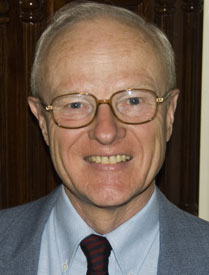 We often strike a hyperbolic note when we declare this or that historian to be the “founder” of a particular intellectual tradition. However, it is hard to over-estimate the influence George Nash’s has had on studies of American conservatism. We would be remiss if we didn’t proclaim his book The Conservative Intellectual Movement In America (1976, 1996, 1998) the one that launched a thousand essays, dissertations, and conference panels. In March 2011, Andrew Hartman asked readers of the blog whether they still read George Nash. The response, one of the best we’ve had at this blog, elicited 39 comments and a long conversation on race and American conservatism.
We often strike a hyperbolic note when we declare this or that historian to be the “founder” of a particular intellectual tradition. However, it is hard to over-estimate the influence George Nash’s has had on studies of American conservatism. We would be remiss if we didn’t proclaim his book The Conservative Intellectual Movement In America (1976, 1996, 1998) the one that launched a thousand essays, dissertations, and conference panels. In March 2011, Andrew Hartman asked readers of the blog whether they still read George Nash. The response, one of the best we’ve had at this blog, elicited 39 comments and a long conversation on race and American conservatism.
In addition to writing his landmark book, Nash has also written Reappraising the Right: The Past and Future of American Conservatism (2009) and is the author a three-volume biography of Herbert Hoover. According to his biography at the Russell Kirk Center (at which he is a senior fellow) “he is also an Associate of the Hauenstein Center for Presidential Studies at Grand Valley State University…a member of Phi Beta Kappa, the Historical Society, the National Association of Scholars, the Calvin Coolidge Memorial Foundation, and the Churchill Centre. From 2006 to 2008 he served two terms as president of the Philadelphia Society, the nation’s oldest organization of conservative intellectuals. In 2008 he was the recipient of the annual Richard M. Weaver Prize for Scholarly Letters, created by the Ingersoll Foundation.”
Nash was kind enough to allow the blog to reprint his remarks from a 2012 OAH panel on conservative intellectuals that he anchored and included Andrew Hartman and Lisa Szefel. Among the revelations that Nash shared at the conference was that as a graduate student he had originally decided to look at Americans for Democratic Action but upon discovering that another graduate had begun work on that topic took the advice of his adviser and looked at the other side of political coin. The rest is here.

0